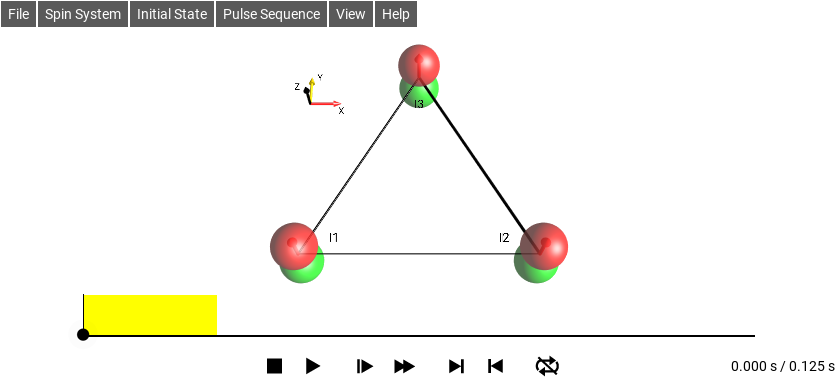SpinDrops¶
SpinDrops is an interactive quantum spin simulator that uses the DROPS Representation to provide a rich visualization of spin system dynamics. The DROPS Representation is a general approach for the visualization of arbitrary spin operators, it is used in combination with a quantum-mechanical simulator to graphically fully illustrate spin system time evolution.
SpinDrops (since version 2.0) is a project of the Glaser Group of the Chemistry Department at the Technical University of Munich (TUM). It is provided to the community free of charge, an can be used on the web, iOS, Android, macos, Linux, and Windows. More information about the project, its goals, and history can be found here.
Quantum systems are displayed with experimental controls:

Fig. 1 The SpinDrops display of a 3-spin system and a simple pulse-delay experiment¶
SpinDrops interactively explores spin dynamics. Changes to the system, experiment or parameters are immediately reflected in the quantum state visualization. This website is organized as a book: chapters Tutorial, Feature Manual, Examples, and FAQ outline the concepts and use of the SpinDrops app, while chapters on Mathematical Background, DROPS Representation, Color Code and Physics provide background on the DROPS representation and spin physics. In addition, there are a number of Challenges for the adept student of spin dynamics to tackle!
Purpose¶
Some primary motivations for the creation of SpinDrops:
Fully see what is going on in an experiment.
Understand the properties of spin operators.
Develop intuition about the effects of pulse sequences.
Become familiar with standard experimental building blocks.
Invent and test novel pulse sequences.
Objectives¶
Some concepts from NMR that can be learned by working and playing with SpinDrops:
Effects of non-selective and selective rotations on spin operators.
Effects of frequency offsets and spin-spin couplings.
How to use various experimental building blocks to manipulate the state of a spin system.
Product operators (antiphase operators, multiple-quantum coherence, coherence order).
Principles of polarization and coherence transfer.
Quickstart¶
SpinDrops is very flexible, and considerable effort has been put into making it easy to use. A typical approach to see the spin dynamics created by a given pulse sequence involves the following steps:
Select a spin system and its parameters (offset frequencies and coupling constants).
Choose the initial state of the spin system (e.g. z magnetization of spin I1).
Pick a pulse sequence (e.g. a 90° pulse followed by a delay).
Run the pulse sequence by pressing the play button ( ► ) and watch the resulting time evolution in the DROPS display.
Spin System properties, such as spin offsets and couplings, can be modified by selecting .
The pulse sequence can be modified by double-clicking on the sequence display.
For more detailed information about using SpinDrops, please see the Tutorial and Feature Manual.
Todo
expand this quickstart